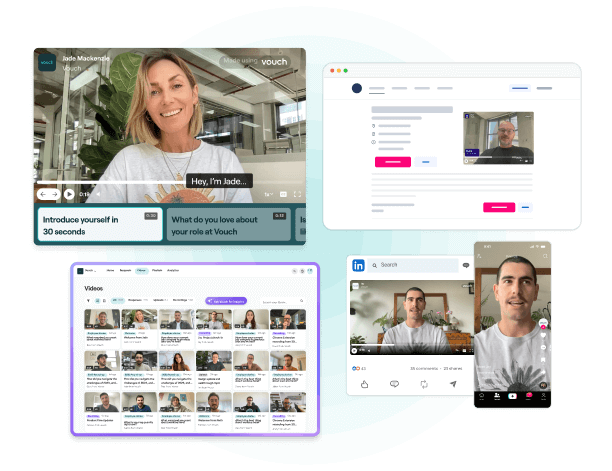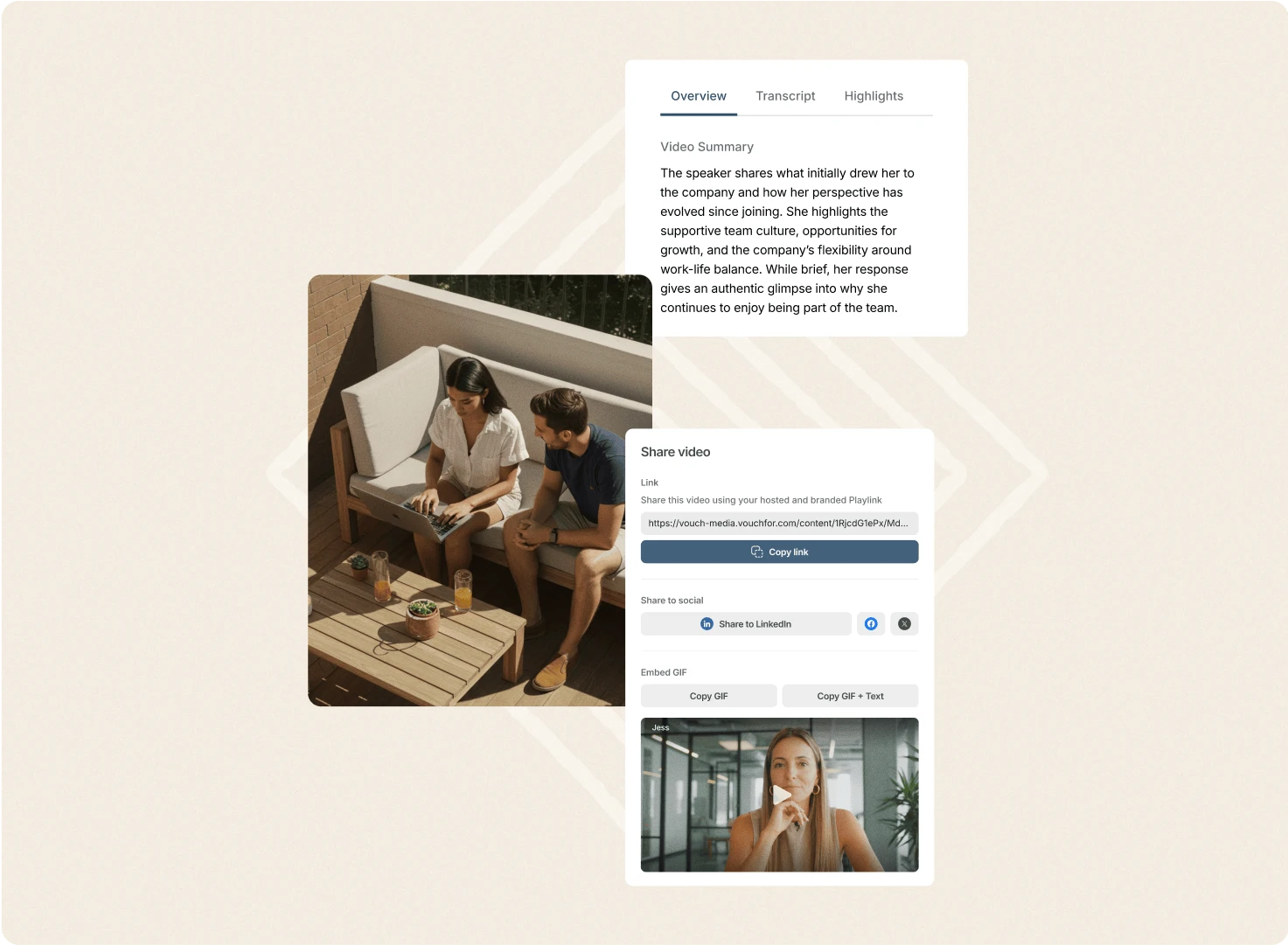Want to hire smarter, retain longer, and stand out in today's brutally competitive talent market?
You're not alone. In 2025, employer branding as a reruitment strategy has officially moved from “nice-to-have” to mission-critical, and the companies getting ahead are the ones that measure what matters.
In this guide, we’re breaking down the employer branding metrics that top HR teams are tracking in 2025, based on real data, real tools, and industry insights.
Let's get started:
Where to Start: Implement Vouch for Authentic Employer Branding Videos
If you do nothing else this quarter, invest in Vouch or a similar tool to capture authentic employee testionials and videos.
Vouch is a leading video platform that’s helping companies like Canva, Flight Centre and HubSpot showcase authentic employee stories to attract top talent.
Why authentic video matters:
- Vouch turns employee-generated video content into assets for careers pages, social media, and recruitment
- Builds trust with candidates by showing real voices, not polished marketing scripts
- Enhances candidate experience, offer acceptance rate, and brand credibility
Check out the companies using Vouch here: https://vouchfor.com/customers
How To Track Your Key Employer Branding Metrics for 2025
Here’s what top HR professionals, recruitment leads, and employer brand managers are tracking this year, with links to reliable sources and tools.
a. Employer Brand Awareness
Are people searching for your company as an employer? Are job seekers sharing your openings? These are early indicators of a healthy employer brand.
Understanding how visible and recognizable your employer brand is in the market, is step one.
How to measure:
- Branded search volume via Google Search Console
- Social media reach and impressions via LinkedIn Analytics or Meta’s Creator Studio
- Number of earned media mentions using tools like Google Alerts or Mention
- Use the analytics in Vouch to understand how people are interacting with your video content
b. Offer Acceptance Rate
According to a LinkedIn report, companies with a strong employer brand see up to 50% lower cost per hire and 28% higher retention.
This is a real-world measure of how compelling your company appears to candidates who receive offers.
Formula:
Offers accepted / Total offers made = Offer Acceptance Rate
c. Candidate Experience Metrics
A poor application process can crush your brand — even before the first interview.
Your ATS or platforms like Greenhouse and Lever help collect this data, but be sure to ask candidates directly post-process, where you can also use Vouch!
Key indicators:
- Time to complete the application
- Candidate drop-off rate during application
- Candidate NPS (Net Promoter Score)
d. Time to Hire
According to Workable, the average time to hire is 33 days, but high-growth companies aim for under 20.
Faster hiring = better candidate experience and reduced cost of vacancy.
How to measure:
Date job posted → Date offer accepted, how many days did it take?
Bring your employer brand to life
- Empower employees’ storytelling
- Transform careers sites with video
- AI-driven video editing
- Publish videos anywhere

e. Cost Per Hire (CPH)
This one's about budget efficiency - and yes, brand impacts it.
According to SHRM (Source), the average cost per hire is $4,700, but it can climb over $20,000 for leadership roles.
Track spend across these platforms to see how your hiring compares:
- Job ads
- Agency fees
- Recruiter salaries
- Employer branding campaigns
- Assessment platforms
f. Quality of Hire
Integrate with your HRIS software like BambooHR or HiBob for tracking, these metrics tracks how well your hires perform and stick around.
Measure quality of hire by:
- 90-day and 12-month retention
- Performance reviews post 90 days in particular
- Understanding satisfaction using post-hire surveys and spotlight videos
g. Employee Retention Rate
The employer brand doesn’t end at the offer letter.
Why it matters:
Retention is a direct reflection of employee experience, engagement, and leadership alignment.
Use Gallup’s Q12 engagement surveys or your own exit interviews to understand why people stay, or leave.
h. Employee Referral Rate
Referrals usually produce the highest-quality, fastest-to-hire, and longest-staying candidates.
What to track via your HR system or ATS:
A referral rate of 20-40% is common in high-trust cultures, per Glassdoor. Track your referal rate to see how it compares.
i. Social Media Engagement
Likes, shares, comments, and saves from your employer branding content on platforms like LinkedIn, Instagram, and TikTok all count.
Use these tools to track social media engagement:
Employee advocacy through Vouch can help skyrocket social reach too.
j. Candidate Source of Hire
Know what’s working. Use your ATS to determine where your top candidates are coming from.
Look at:
- Organic careers site traffic (use Google Analytics)
- Job boards
- Social media
- Employee referrals
What HR Tools Can Monitor Employer Brand Metrics?
Modern HR tech stacks help you track, optimize, and automate employer branding insights.
Here are the essential tools to look into:
- Vouch → Video testimonials, Employer Branding & communications
- Greenhouse → ATS & hiring analytics
- Lever → Full-funnel recruitment CRM
- BambooHR → HRIS and retention tracking
- Google Search Console → Employer brand visibility
- LinkedIn Talent Insights → Competitive benchmarking
- Glassdoor for Employers → Brand reputation monitoring
- Sprout Social → Social listening and engagement
- Mention → Media mentions and alerts
Who Are The Top 10 Global Employer Brands in 2025?
Here’s a list of direct employers, not recruitment agencies, who are winning with employer branding, backed by retention, reputation, and revenue.
- Google ~180,000 employees | $325B revenue
https://about.google - Salesforce ~80,000 employees | $35B revenue
https://www.salesforce.com - Microsoft ~221,000 employees | $250B+ revenue
https://www.microsoft.com - Adobe ~30,000 employees | $20B revenue
https://www.adobe.com - HubSpot ~7,500 employees | $2.2B revenue
https://www.hubspot.com - Canva ~3,500 employees | Private
https://www.canva.com - Shopify ~11,600 employees | $7B revenue
https://www.shopify.com - Unilever ~128,000 employees | $65B revenue
https://www.unilever.com - Netflix ~13,000 employees | $38B revenue
https://www.netflix.com - Atlassian ~11,800 employees | $4.4B revenue
https://www.atlassian.com
Dive Deeper with These Vouch Articles
Get even more practical guidance from the Vouch blog:
- Why Candidate Experience Drives Retention
- How to Nail Your Employer Brand Video Strategy
- The Rise of Employee-Generated Content
FAQs
What’s the most important employer branding metric today?
Quality of hire and candidate experience — because they reveal if you’re attracting and keeping the right talent.
How do I measure candidate satisfaction?
Use NPS-style surveys post-interview or post-offer. Ask about their application and interview experience.
What tools help track employer brand reputation?
Try Google Alerts, Glassdoor for Employers, and LinkedIn Talent Insights.
How can I improve offer acceptance rates?
Highlight real employee stories with tools like Vouch, be transparent about salary, and personalize the offer process.
What’s a good referral rate benchmark?
20–40% is a solid goal depending on your industry. Lower may signal weak internal engagement.
How do I reduce time to hire without hurting quality?
Use pre-screening tools, AI-based ATS systems, and streamlined interview processes.
How does employer branding support diversity hiring?
Showcase diverse voices in your brand content and build inclusive candidate journeys. Transparency builds trust.
See Why Employer Brand Managers Love Vouch!
Loved by companies like Canva, Nike, Cisco, HubSpot, Amazon and more, tools like Vouch make leveraging video in your business remarkably easy.
Be sure to book a Vouch demo today and chat with a video content expert.
You might also like

Elevate Your Brand Today With Vouch
Discover how Vouch can accelerate talent acquisition while helping you stay on-brand.






